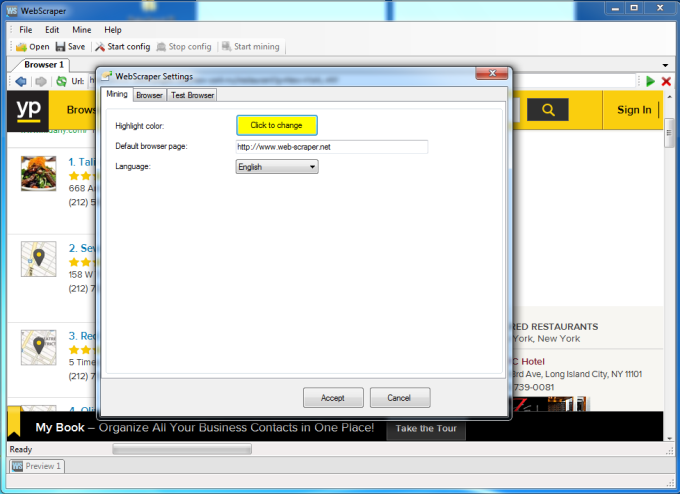

You can find a full list of all available codes on Wikipedia.
HTT WEBSCRAPER CODE
A code of 200 means the request was properly handled. On the first line, we have a new piece of information, the HTTP code 200 OK. Sometimes we will have to spoof this header to get to the content we want to extract.Īnd the list goes on.you can find the full header list here.Ī server will respond with something like this: HTTP/1.1 200 OK For example, lots of news websites have a paying subscription and let you view only 10% of a post, but if the user comes from a news aggregator like Reddit, they let you view the full content. This header is important because websites use this header to change their behavior based on where the user came from. Referer: The referrer header (please note the typo) contains the URL from which the actual URL has been requested.Your browser will receive that cookie and will pass it along with all subsequent requests. When you submit a login form, the server will verify your credentials and, if you provided a valid login, issue a session cookie, which clearly identifies the user session for your particular user account. However, they are a vital browser feature for mentioned authentication. Cookies are used for a number of different purposes, ranging from authentication information, to user preferences, to more nefarious things such as user-tracking with personalised, unique user identifiers. This could be either up to a certain date of expiration (standard cookies) or only temporarily until you close your browser (session cookies). Cookies are one way how websites can store data on your machine. Cookie : This header field contains a list of name-value pairs (name1=value1 name2=value2).There are lots of different content types and sub-types: text/plain, text/html, image/jpeg, application/json. Accept: This is a list of MIME types, which the client will accept as response from the server.This is exactly what we will do with our scrapers - make our scrapers look like a regular web browser.

Because these headers are sent by the clients, they can be modified ( “Header Spoofing”). This header is important because it is either used for statistics (how many users visit my website on mobile vs desktop) or to prevent violations by bots.

In this case, it is my web browser (Chrome) on macOS. User-Agent: This contains information about the client originating the request, including the OS.This header is particularly important for name-based virtual hosting, which is the standard in today's hosting world. Host: This header indicates the hostname for which you are sending the request.Here are the most important header fields : Here is an exhaustive list of HTTP headers Multiple headers fields: Connection, User-Agent.In this tutorial, we will focus on HTTP 1. In the case here, the directory product right beneath the root directory. The path of the file, directory, or object we would like to interact with.for uploading data), and a full list is available here. There are quite a few other HTTP methods available as (e.g. In our case GET, indicating that we would like to fetch data. In the first line of this request, you can see the following:
HTT WEBSCRAPER MAC OS X
User-Agent: Mozilla/5.0 (Macintosh Intel Mac OS X 12_3_1) AppleWebKit/537.36 (KHTML, like Gecko) Chrome/1.127 Safari/537.36 FTP, for example, is stateful because it maintains the connection.īasically, when you type a website address in your browser, the HTTP request looks like this: GET /product/ HTTP/1.1Īccept: text/html,application/xhtml+xml,application/xml q=0.9,image/webp,*/* q=0.8 HTTP is called a stateless protocol because each transaction (request/response) is independent. Then the server answers with a response (the HTML code for example) and closes the connection. An HTTP client (a browser, your Python program, cURL, libraries such as Requests.) opens a connection and sends a message (“I want to see that page : /product”) to an HTTP server (Nginx, Apache.). HyperText Transfer Protocol (HTTP) uses a client/server model. The goal of this article is not to go into excruciating detail on every single of those aspects, but to provide you with the most important parts for extracting data from the web with Python. The Internet is complex: there are many underlying technologies and concepts involved to view a simple web page in your browser. Note: When I talk about Python in this blog post, you should assume that I talk about Python3. Of course, we won't be able to cover every aspect of every tool we discuss, but this post should give you a good idea of what each tool does and when to use one. We will go from the basic to advanced ones, covering the pros and cons of each. In this post, which can be read as a follow-up to our guide about web scraping without getting blocked, we will cover almost all of the tools to do web scraping in Python.


 0 kommentar(er)
0 kommentar(er)
